Best Product Management Tools in 2025 - Pricing, Reviews, and Demos

In any tech business of any scale, product management can be tough. Aligning cross-functional teams, roadmapping, tracking progress – product managers have so much to handle. And growing in importance. “I don’t think every company understands the role of product management and why it’s important,” says Richard Humphrey, CPO, Contruent. “But throughout my career it’s become more and more important – it’s gone from cat herder to one that’s super strategic.”
Fortunately, the best tools for product managers have evolved with the discipline, and have the power to make your work easier. But what are some of the most important features in the best product management software? In this guide, we’ll explore all the key features to look out for and give you some advice on choosing the right solution for your teams.
“As a product ops professional, managing the product organization’s tool stack is one of the core components of your job. And within that remit I want you to remember two thing,” says Antonia Landi, Product Operations Consultant and Coach: “Firstly, only introduce a new tool to the stack if you have exhausted all of your other options, and secondly, a smaller tool stack will always outperform a bigger one. As much as possible, resist the urge to add to your tool stack unless no other option has been deemed suitable, and work to find tools that can do more things in the same place. But above all, you must ensure that you have one single source of truth for all of your most important information: Strategy, feedback, and data. Reduce the need for constant manual intervention and prioritize tools with two-way integrations and the right amount of flexibility for your teams.”

© 2011 Martin Eriksson. Re-use with appropriate attribution (Via Mind The Product).
What makes the best product management software great in 2025?
Product managers now have access to multi-functional tools that allow them to communicate, collaborate, and coordinate more fluidly than ever. Using the best product management tools, they can make data-driven decisions that empower teams to channel their time and energy into the most valuable tasks. They can create transparency, alignment, and enable growth – ultimately, to ensure businesses are releasing products and updates that align with user needs and business objectives.
The widespread adoption of agile methodologies has also gradually transformed product management, opening the door to a more flexible and iterative development process. Instead of following a rigid structure that may be constraining and make reacting to external changes difficult, PMs can adapt and update workflows as needed, ready for the next iteration.
However, as PMs have become indispensable to businesses in the tech space, the amount of information they need to analyze and the number of colleagues they deal with can be difficult to manage – it’s ever-increasing. "The volume of requests has increased, customers' access to product teams has increased. They demand it. You're seeing all these new companies pop up that are taking incumbent market share... being able to be responsive is more and more important,” says Ken Thompson, VP of Product at Melbourne-based startup, Kitebuild.
That’s why PMs depend on the latest, AI-leveraging, intuitive product management software to stay on top of their work and efficiently achieve goals. Simplifying and streamlining daily tasks is critical, and a holistic product management platform that spans strategy to delivery can help.
Here’s how airfocus’s CEO, Malte Scholz, sees it: “I started airfocus as a side project, when I was working as a product manager, because I was frustrated with Excel and PowerPoint. Using them was like drilling a hole with a hammer. It's hard to use them when you don't have everything in one place – I was spending so much time data managing, and cross-communicating, rather than getting on with the job. Technology has the power to give you your time back, create clarity and allow us to do more with less – it’s a hugely valuable tool in today’s product management world, and choosing the right one is important.”
The chances are that you’re here because you’re looking to save time updating roadmaps and plans, want to create a single source of truth for your team and stakeholders, want product management software that’s more flexible than what you currently have… or to get strategic alignment. So what should you be looking for in a tool to solve those challenges?
First, let's answer some of the common questions product managers have when seeking out the best product management software.

What is a product management tool used for?
Product management tools are indispensable in the modern product manager's toolkit, designed to address various aspects of product development and management. At their core, these tools aim to simplify, streamline, and enhance the processes involved in taking a product from conception to market. Here are some of the uses of product management software (not all tools may have all of these, but they may have one or more of these functions).
Only 28% of Product Managers believe they have an “optimized” product-development process. (Gitnux 2024)
Strategic planning: These tools help managers plan product lines and future developments. They provide frameworks for mapping out both short-term and long-term strategies, ensuring that every step aligns with the overall business objectives.
Roadmapping capabilities: This allow for visualizing progress and timelines, making it easier to communicate the product vision to stakeholders and align all team members.
Task and project management: Managing the many tasks that come with product development can be daunting. Product management tools facilitate the organization of these tasks, enabling managers to assign responsibilities, set deadlines, and track progress in real-time. This ensures that the product development process remains on schedule and that all team members are aligned and accountable.
Collaboration and communication: As products are rarely developed in silos, fostering effective communication across different teams, be it marketing, sales, development, or customer support, is crucial. Product management tools offer integrated communication features that help break down silos, facilitate seamless interactions, and ensure that every team member is on the same page.
Prioritization and decision-making: With constant feedback loops from customers and ongoing market research, product managers are often inundated with data. Product management software helps in analyzing and prioritizing this information, enabling managers to make decisions based on data-driven insights. Features like scoring systems, priority matrices, and roadmaps aid in evaluating the impact of potential decisions and prioritizing tasks and features accordingly.
Feedback and data analysis: Gathering and analyzing customer feedback is crucial for iterative development. Product management tools integrate various forms of feedback collection, such as surveys, comment sections, and analytics, to gauge customer satisfaction and identify areas for improvement. This continuous loop of feedback and refinement is essential for developing products that truly meet customer needs.
Resource allocation and budget management: Effective resource management is key to successful product development. These tools provide insights into how resources are being utilized, helping managers allocate time, budget, and manpower efficiently. By keeping track of resource usage, product managers can avoid overallocation and ensure that each aspect of the product development is adequately funded and staffed.
Product management tools are more about managing a product's success than just managing a product. They serve as a central platform (a product operating system) that empowers product managers to excel in their roles, from strategists and analysts to communicators and leaders.
A fully optimized product manager could increase company profits by 34.2% (UXcam 2024)
As we explore the best product management tools of 2025, we will see how each is uniquely equipped to handle the diverse needs of modern product teams.
Must-have features of the best product management tools
When looking for powerful product management software, understanding the range of features available can help make the selection process much easier. The top product management tools offer an extensive array of features that allow PMs to work in the way that suits them best.
What are the most important features to look out for in a product management platform? Here are some key features to consider:
Customisable roadmaps
Roadmaps are great, when they’re up to date. They visualize the main goals and strategies, creating a clear structure with room for adjustments along the path to completion. Visualizing product direction helps align teams with at-a-glance information on the key stages and processes involved in a project.
The best product management tools offer the flexibility to create customizable roadmaps. Instead of being tied to templates, you should be able to devise plans that fit your unique product-management needs.
airfocus’s product roadmapping software empowers you to align everyone around a single vision quickly and easily – static roadmaps are a thing of the past. You can:
Build lead roadmaps in minutes: airfocus’s user-friendly roadmap builder is ideal for crafting lean roadmaps with a variety of visual formats to explore. Developing the right roadmaps for different teams and stakeholders is easy from the start. Need to make updates? That’s straightforward too.
Use different views for effective planning: With airfocus's roadmapping software, you can take advantage of release and timeline views for tracking progress in varied ways. Identify your core objectives and milestones, then plan around them in seconds. When they’re ready to go, share roadmaps with different audiences safely with secure URLs and exports.
Consolidate roadmaps for a comprehensive overview: airfocus makes it easy to consolidate multiple roadmaps into one portfolio and provide a clear overview of the work performed across multiple teams. Streamline and unify cross-functional collaboration.
Prioritization frameworks

Prioritization frameworks like RICE, Kano, MoSCoW, and more help teams weigh up opportunities before taking action. This helps minimize the risk of wasting time and resources on products or features of little value.
The top product management tools should make prioritization simple. airfocus's product prioritization tool does just that.
Use custom scoring frameworks: With airfocus, you can create your own scoring frameworks and identify the most important features to work on in the most practical way. Get an overview of your entire portfolio and track priorities across all teams.
Make prioritization interactive with Priority Poker: airfocus's built-in Priority Poker helps PMs make prioritization more interactive and collaborative. Align teams around prioritization scores and pinpoint gaps in decisions to reach agreements on new tasks more efficiently.
Leverage customer feedback: What better way to prioritize features than to take inspiration from the users themselves? airfocus allows you to incorporate customer insights to prioritize the most-requested features and make changes that matter.
Capacity planning
Even the best teams only have so many hours in the day. That’s why you need to know where and how to invest time and resources. In some cases, you may need to invest in extra resources and bring in more skilled professionals to ensure that products are completed successfully.
This is where proper capacity planning comes in. As one of the best product management tools on the market, airfocus's capacity planning feature simplifies resource management in exciting ways.
Manage resource allocation with a centralized view: Allocate resources to the right planning segments quickly in a single view. Adjust plans and update priorities in seconds.
Make informed decisions with scenario planning: airfocus's scenario planning allows you to compare possible situations and understand resource trade-offs.
Boost efficiency and align teams: Prioritize tasks based on capacity to avoid overloading teams and make sure everyone has the resources to achieve their goals.
Objective & key results (OKRs)
OKRs are a framework that helps PMs set easily measurable goals. By using the OKR framework, PMs can explicitly define what needs to be achieved, like increasing user engagement, and establish trackable results, like X number of extra sign-ups per month.
As one of the best product management tools, airfocus's OKR software for product teams helps align product decisions with company goals.
Connect OKRs to workflows and roadmaps: Monitor progress in one centralized place by linking OKRs to your roadmaps and workflows.
Track progress automatically: Identify objectives that may be at risk and implement impactful changes with automatic progress tracking.
Be more transparent: By making OKRs accessible to all team members, you can show individuals how their work is contributing to your shared success.
AI-powered insights & assistance
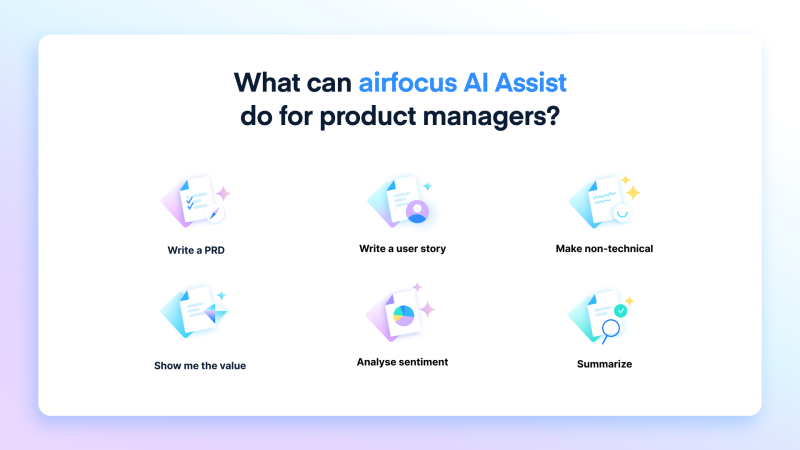
AI is an increasingly popular feature of the top product management tools. When implemented correctly, AI supports decision-making and prioritization by streamlining key processes.
Thanks to airfocus's AI Assist, you can leverage AI for planning, summarizing, and making decisions with improved efficiency.
Prompts and quick-start capabilities: With AI Assist, PMs have access to powerful prompts in item descriptions and comments to help them get creative sooner. Generate ideas with ease, fill blank pages with first drafts in moments, and save valuable time.
Say goodbye to writer’s block: Take advantage of slash commands to dive into a first draft and start iterating with minimal delay. Edit suggestions in less time and take your efficiency to the next level.
Analyze feedback and cut down on jargon: AI Assist helps PMs analyze the sentiment of feedback instantly and simplify jargon-heavy text to make ideas accessible to all audiences.
Customer feedback management
Gathering feedback is essential for understanding what users think of your products and features, and for gaining invaluable insights that inspire future updates. But collecting feedback from multiple sources and keeping it organized can be tricky.
But with the best product management software at your disposal, you can create a single source of truth. “You should already have a good understanding of your product teams’ modus operandi – and you’ll be intimately familiar with just how much work is on their plate,” says Antonia Landi, a Product Operations Consultant and Coach.
“Your primary directive is to create the systems that will allow your teams to more seamlessly and more regularly integrate customer feedback into the existing ways of working. If your customer feedback is scattered across tools, consider consolidating it into one single source of truth – but be wary of feature creep and buying fancy solutions that just turn out to be too complicated to keep up to date. Additionally, examine your existing templates, rituals, and standing meetings to identify places in which you can surface customer feedback data regularly, and allow your product teams to exchange and voice their opinions. It’s all about creating a positive habit - not forcing yet another task onto your teams!”
Fortunately, the best product management tools help you centralize feedback and analyze it to inform your product strategy. airfocus's feedback management tool helps you sort through feedback and take positive action all in one place.
Collate feedback for clarity and convenience: Bring all feedback together in one inbox, pulling it from chat, email, support, and other channels.
Turn insights into ideas: Link customer feedback to elements in your backlog to discover valuable new possibilities. Use often-requested ideas to prioritize tasks and deliver products customers want.
Manage feedback and close the loop: Arrange and visualize feedback in the best format for your team with extensive customization. Update customers on your product and how you’re addressing their needs by listening to their input.
"We've started using [airfocus] for customer feedback,” says Ken Thompson, VP of Product, Buildkite. “All of our customer feedback – we get maybe five to 10 feedback requests a day – are assigned to initiatives and we have that visibility, and give that back to our stakeholders to say why we're working on something… or just why we're not working on something else. You've got to be more customer service oriented than just having your roadmap and plowing away and shipping stuff once a month."
Seamless integrations
The best product management tools can be synced with other tools you use daily, like Trello, Slack, Jira, and Azure DevOps (just to name a few). Choose a tool with limited integrations, and you could find yourself juggling multiple tools and struggling to track progress properly. This could lead to oversights, misunderstandings, and missed updates.
airfocus's seamless integrations make it easy to connect and sync with your existing tech stack.
Integrate with all the dev tools you need: Sync airfocus with dev tools like Microsoft Planner, Shortcut, GitHub, Webhooks, Zapier, and more.
Connect to key feedback tools: Connect airfocus to popular feedback tools like Salesforce, Slack, and Zendesk. Centralize feedback to save time and effort.
Keep everyone updated and linked: airfocus's seamless integrations make product management easier, and bring together cross-functional teams using different tools.
What enterprise product management software must deliver — and how airfocus meets the challenge
Enterprise organizations face a unique set of challenges when it comes to product management. With multiple teams, product lines, stakeholders, and systems to coordinate, the stakes are higher — and so is the complexity. The right enterprise product management software must not only scale, but also bring clarity, alignment, and control across a fast-moving product portfolio.
airfocus is built to meet these needs head-on. From advanced prioritisation frameworks to modular architecture and enterprise-grade compliance, here’s how airfocus supports enterprise product teams:
Scalability and flexibility airfocus offers a modular setup with fully customisable hierarchies, fields, and workflows, allowing teams to adapt the platform to their own structures — whether they’re managing one product or coordinating across an entire portfolio.
Strategic alignment Enterprise leaders need confidence that their teams’ efforts are moving the business forward. airfocus enables this by linking product roadmaps with OKRs and strategic objectives, and rolling up views across portfolios to provide visibility at every level of the organisation.
Prioritization across complexity With multiple stakeholders and competing initiatives, clear prioritisation is essential. airfocus includes built-in frameworks like RICE, MoSCoW, Kano, and Priority Poker, as well as custom scoring options, so product teams can make transparent, data-informed trade-offs.
Capacity and resource planning To avoid bottlenecks and optimise delivery, airfocus provides visual tools and scenario planning features that help teams allocate resources effectively across projects and teams.
Centralized feedback management airfocus captures and organises feedback from customers, sales, support, and internal stakeholders in one place. Teams can easily connect this feedback to relevant initiatives or backlog items, helping them stay focused on what users actually need.
Security and compliance airfocus meets the strictest enterprise requirements, including GDPR, SOC‑2, and ISO 27001:2022 compliance. It also offers EU or US data hosting options to support regional needs and privacy policies.
Fast onboarding and deep integrations airfocus is designed to deliver value quickly, with most enterprise teams onboarded within 30 days. It integrates seamlessly with tools like Jira, Azure DevOps, Salesforce, and GitHub — minimising disruption and ensuring smooth adoption.
Enterprise-grade support From day one, enterprise clients benefit from tailored onboarding, expert guidance, and a named customer success manager to ensure long-term success and alignment.
With airfocus, enterprises don’t have to choose between speed and sophistication. Its product operating system offers the depth and structure large organizations need, while remaining intuitive and fast to implement. That means faster alignment, better decision-making, and more confident delivery — all in a platform that can grow with you.
airfocus also offers a flexible configuration process, empowering you to create your own set of tools and build better products for customers. With airfocus enterprise, you can hit the ground running with a dedicated product management specialist for your first three months.
Why airfocus is the best product management tool
When weighing up the best product management tools, airfocus has everything you need. It delivers all these key features in one unified platform with comprehensive customization capabilities and extensive integrations.
Using airfocus, product managers working with small teams can transform their processes and create a more streamlined, effective approach. It helps PMs understand customers, prioritize features, and track progress across multiple teams — all in one place.
And airfocus is ideal for enterprise organizations, too. Bring customer feedback from many channels together to gain insight into different needs, sync all your essential tools, and align large teams around custom roadmaps to maintain forward momentum.
If you’re frustrated by outdated product management tools, airfocus is the ultimate all-in-one solution.
Read our range of product management case studies from airfocus users.
Choosing the right platform for your product team
When looking for the best product management tools for PMs, you need to focus on the following features:
Roadmapping
Prioritization
Capacity planning
OKRs and progress tracking
AI support
Customer feedback management
Tool integrations
Security and compliance
Finding a tool that brings together all of these elements into a single source of truth helps your team be more effective and efficient. While browsing tools for product managers, always consider your current pain points (e.g., lack of alignment, poor collaboration) and how you intend to grow in the future.
Focus on finding the right product management software for your unique needs and explore all available features. Don’t make purchase decisions purely on pricing or what you’ve heard through the grapevine.
Crucially, work together to pick the right tool for your business: get input from all teams to understand which features and functions will benefit everyone.
Get started with airfocus today
Ready to learn more about how airfocus can revolutionize your product management? Book your interactive demo to discover the power of airfocus today!
What are the other best product management tools?
The 35 tools reviewed are divided into 10 categories that represent most functions related to product management. Each tool is listed with its pros and cons, pricing, availability of free trial and demo and G2 rating.
Here is an overview of some of the most prominent tools on the list:

Category 1: All-in-one product management tool for 2025
1. airfocus
As we've outlined above, airfocus is the most flexible and user-friendly product management platform that supports the full spectrum of product management activities, from strategy formulation to roadmap execution.
Designed to be a single source of truth for product teams to manage all their work, airfocus is packed with features that aid in strategy and prioritization, backlog management, roadmapping, customer feedback integration, and OKR management.
Ratings: G2 - 4.4 stars
Demos: Getting Started with airfocus.
Pricing: Plans start at $59 per editor per month.
Free trial: No.
Pros
Get started quickly and easily with great templates.
Fully customizable to fit your brand and workflow.
Intuitive filters to see what you need and nothing you don’t.
Great prioritization functionality.
Expert customer service.
Huge resources area.
Plenty of integrations.
Cons
We’ll get back to you if we find any ;)
Category 2: Strategy and prioritization
2. Aha!
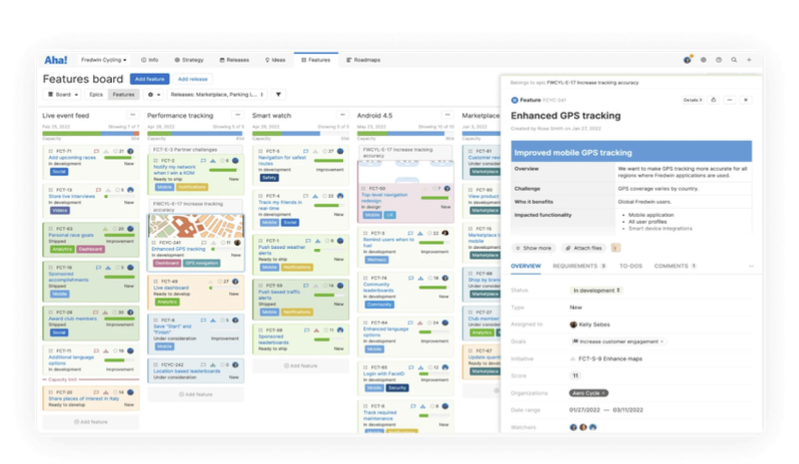
Aha! is a roadmap platform tailored for product teams to craft roadmaps and share their plans for product development. Its capabilities extend beyond this function however, as it also aids in formulating product strategy and prioritization.
For strategy, it supports outcome based roadmaps, offering free OKR roadmap templates that not only enable teams to tie initiatives to the company vision, but also provides the ability to track confidence, and even a weighted OKR template so teams have the flexibility to calibrate results based on the significance of their goals.
Using Aha! Ideas, teams can harness the power of crowdsourcing to gather feedback and gain valuable customer insights. Facilitating prioritization, users have the ability to participate in the idea submission and management process by voting on suggestions.
Stakeholders and team members can express their support for particular ideas, helping teams prioritize and focus on the most popular or impactful ones. This facilitates collaboration among the team, helping to ensure that the most valuable ideas rise to the top for consideration and implementation.
Ratings: G2 - 4.3 stars
Demos: Aha! Roadmaps | Getting Started.
Pricing: Plans start at $59 per user per month.
Free trial: Yes.
Pros:
Easy integration.
Project management.
Team collaboration.
Customization.
Ease of use.
Cons:
Difficult to get to grips with.
Lacks key features compared to others.
Confusing UI.
Customization is limited.
3. Airtable

Airtable is a cloud-based software platform that combines the functionality of a spreadsheet with the power of a database. Users can create, manage, and collaborate on various types of data, including project plans, customer databases, task trackers, inventory management, and more.
What sets Airtable apart from traditional spreadsheets is its flexibility and rich feature set. Users can organize their data into customizable tables, similar to a spreadsheet, but with additional features like attachments, collaboration tools, and powerful filtering and sorting options.
Product teams use Airtable as a versatile tool to manage various aspects of product management including idea management, roadmap planning, collaborating with cross-functional teams, integration with other tools, and more.
For strategy, users can utilize its OKR tracking template. In addition to this, its product strategy template supports product managers with bringing together product and marketing teams to ensure that goals are met.
With its matrix blocks, product teams can map out their product strategy from existing data defining how their initiatives will support company goals.
Rating G2 - 4.6 stars
Demos: Yes. Available on their website.
Pricing: Airtable is free for individuals or very small teams who just want to get started. For 50,000 records per base, Gantt and timeline view, Standard sync integrations and more, the cost starts at $24/user/month.
Free trial: Yes.
Pros:
Easy-to-use
Interconnected apps and workflows
Plenty of integrations to choose from
Cons:
Restrictive set up for roadmaps
Requires knowledge of connecting apps and complex databases
Has a limitation on records and file uploads
4. Coda
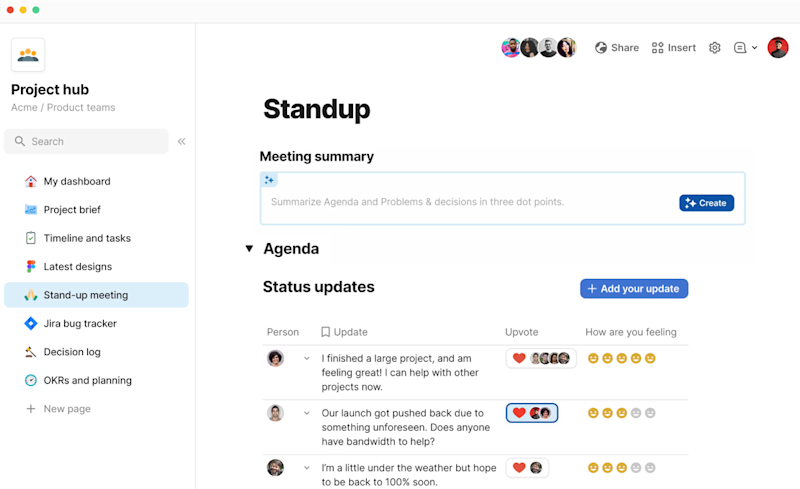
Coda merges the functionalities of documents, spreadsheets, and presentations into a single platform. This tool is designed to enhance productivity by offering a unified workspace for document handling and project management.
Rating: G2 - 4.7 stars/
Demos: Available on their website.
Pricing: Coda has a free version for those starting out. The pro package starts at $12 per month.
Free trial: Yes.
Pros:
Combines features from various traditional office tools.
Facilitates collaboration with a shared workspace.
Offers a wide range of community-built templates.
Cons:
Can be overwhelming for new users due to its broad functionalities.
May experience slowdowns with extensive data.
Heavy reliance on templates might restrict custom solutions.
5. Visor
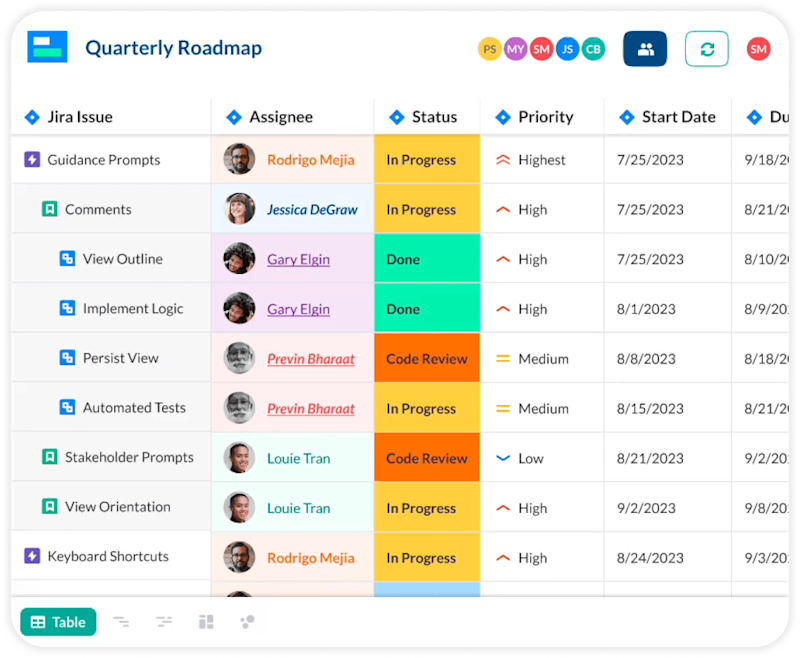
Visor is a collaboration software tailored for creating, sharing, and tracking product roadmaps. Suitable for both startups and large companies, it supports teams in maintaining organization and visibility throughout the product development process.
Rating: G2 - 5 stars (4 reviews)
Demos: The website doesn't mention a demo.
Pricing: Visor's paid plans begin at $9 per user per month, and they also provide a basic free forever plan.
Free trial: Yes.
Pros:
Offers bi-directional synchronization with Jira, ensuring roadmaps stay current and integrated.
Supports multiple roadmaps for managing various projects simultaneously.
Enables easy sharing with team members and stakeholders, promoting transparency and alignment.
Cons:
The wide array of features might complicate the user experience for newcomers.
Dependency on integrations like Jira may limit utility for teams not using these platforms.
Advanced features are gated behind the paid plans, which might be a barrier for smaller teams or individual users.
Category 3: Backlog Management
6. Jira
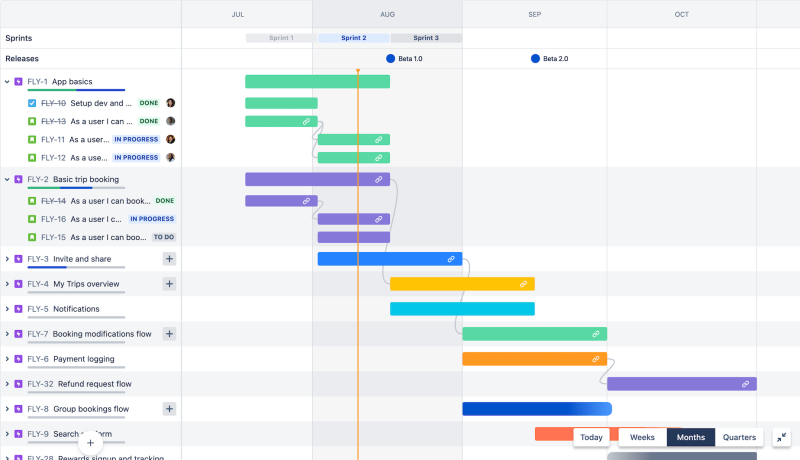
Originally designed to track software bugs, Jira has evolved into a robust platform for managing various product management tasks. It's highly regarded among agile teams for supporting the full software development life cycle, from tracking customer service requests to managing development backlogs.
Ratings: G2 - 4.3 stars
Demos: Project Management with Jira | Atlassian.
Pricing: Plans start at $8.15 per user per month.
Free trial: Yes, for up to 10 users.
Pros:
Offers powerful roadmapping capabilities, suitable for both short-term and long-term planning.
Highly customizable to fit different workflows and scales to accommodate many users and tasks.
Features a kanban-style board for visual task management, enhancing its versatility for agile development.
Cons:
Mobile and remote work functionality is somewhat limited, which may not suit all working styles.
Integrations can be complex and time-consuming to configure.
Recent design changes may disorient long-time users, despite potentially benefiting new users.
7. Monday
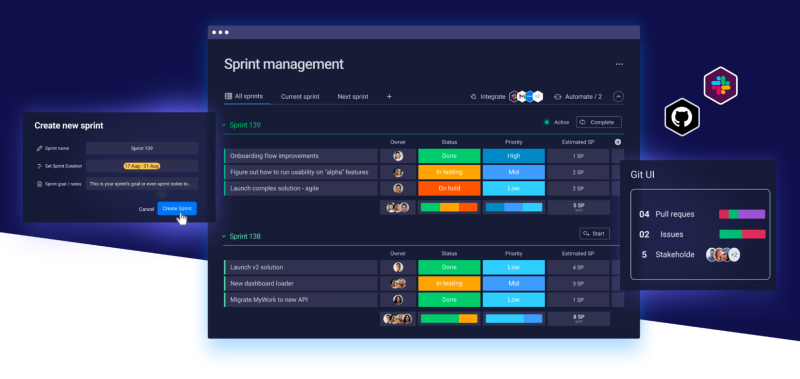
Monday and Monday Dev is tailored for software project management. It enhances traditional project management tools by integrating backlog management, roadmap planning, and bug tracking into a unified platform.
Ratings: G2 - 4.7 stars
Demos: monday dev overview (enterprise) | monday.com tutorials.
Pricing: Plans start from $9.80 per seat per month.
Free trial: Yes.
Pros:
Offers a user-friendly interface that boosts efficiency and simplifies project tracking.
Provides advanced reporting features and a variety of visualization options, including burndown charts for comprehensive project analysis.
Includes over 200 integrations and multiple tools for sprint management, catering to diverse product management needs.
Cons:
The mobile app's functionality is limited compared to the desktop version, affecting on-the-go usability.
Some advanced features may be difficult to locate within the platform's extensive menu.
The interface can appear cluttered, which might overwhelm new users.
8. Backlog
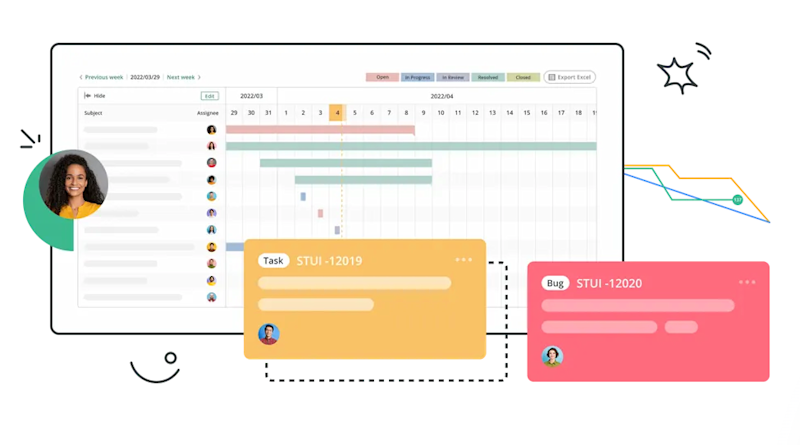
Backlog by Nulab is a project management tool designed to enhance collaboration among team members, including developers, clients, designers, and other stakeholders. It centralizes communication and project tracking on a single online platform, making it a valuable reference point for all involved.
Ratings: G2 - 4.5 stars
Demos: The website doesn't include a demo.
Pricing: Free plan for up to 10 users, then packages start at $35 per month.
Free trial: Yes.
Pros:
Specifically built for programmers, featuring tools like a diff checker, version control, and code merging capabilities.
Facilitates comprehensive collaboration across various team roles.
Offers a range of pricing options, including a free tier and a robust Enterprise Plan with a 30-day free trial.
Cons:
Not built for product management.
Lacks features like a time-tracking widget and accounting app integrations, which may limit its appeal to non-programmers.
Other general project management apps might offer more comprehensive tools for non-programming teams.
The interface and feature set may be too specialized for teams not heavily involved in programming tasks.
9. Productboard
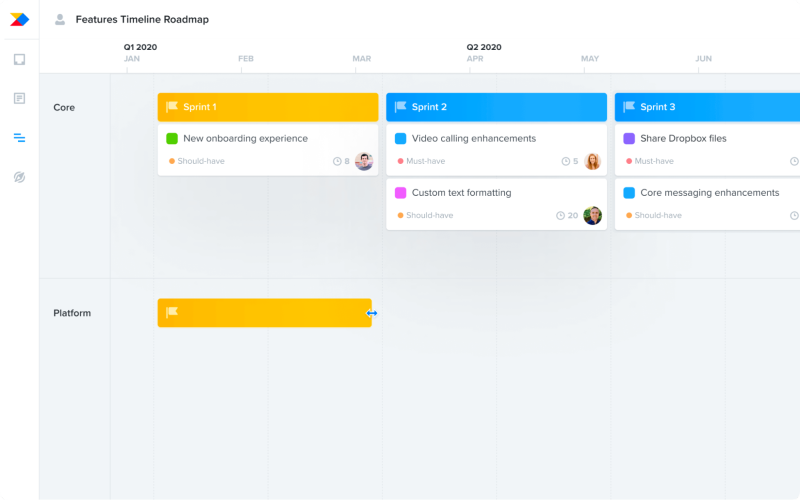
Productboard supports product teams in gathering insights, prioritizing tasks, and aligning stakeholders with interactive roadmaps. Serving over 6,000 customers, it offers a comprehensive suite of services including onboarding, customer success, and priority support tailored to enterprise needs.
Ratings: G2 - 4.3 stars
Demos: You can request a demo on the website.
Pricing: A free limited plan is available. Packages start at $25 per user per month.
Free trial: Yes.
Pros:
Enables the creation of interactive, customizable roadmaps to effectively track progress.
Features a product portal for collecting and acting on customer feedback.
Offers multiple integrations with essential enterprise tools and robust API support.
Provides a professional services team to facilitate onboarding and ensure customer success.
Cons:
Integrations and API support are limited to the most commonly used delivery tools, which may not cover all enterprise needs.
The internal insights tool does not distinguish between customer insights and internal team insights, complicating impact assessments.
The onboarding process can be complex for individuals without a product management background.
Pricing concerns, particularly regarding the high cost and subscription model, have been noted by some users.
Category 4: Roadmapping
10. Trello
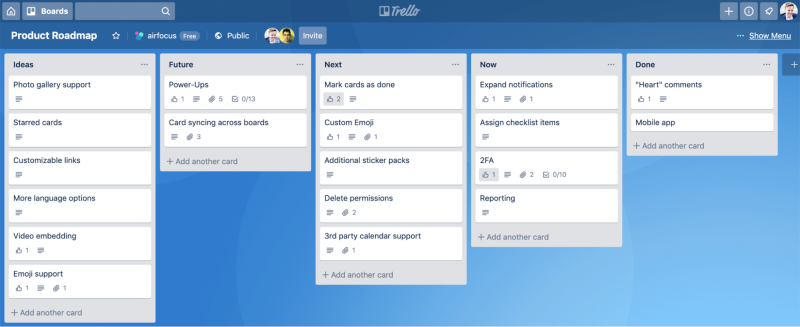
Trello, known for its kanban-style app interface, allows users to manage tasks effectively by organizing cards with metadata such as tasks, due dates, and assignees. It facilitates the organization of tasks by deadlines and development stages. Visually appealing and easy to use, Trello stands out as a user-friendly platform that simplifies roadmap creation in a few clicks.
Ratings: G2 - 4.4 stars
Demos: Boost your productivity with Trello.
Pricing: Plans start at $5 per user per month.
Free trial: Yes.
Pros:
Intuitive and easy to learn, allowing users to get started quickly.
Offers a wide range of integrations for enhanced automation and data sharing.
Provides a generous free plan that is adequate for many users without needing an upgrade.
Users can customize cards within each board to suit their preferred workflow, offering some flexibility and personalization with their roadmap.
Cons:
Not suitable for larger, more complex projects due to its simplicity.
More advanced features are available only through paid plans.
Free plan users face storage limits, pushing towards paid upgrades for more storage and features.
Trello is primarily a task management tool rather than a specialized product management solution. This limitation is evident in its lack of robust roadmapping capabilities.
11. Wrike
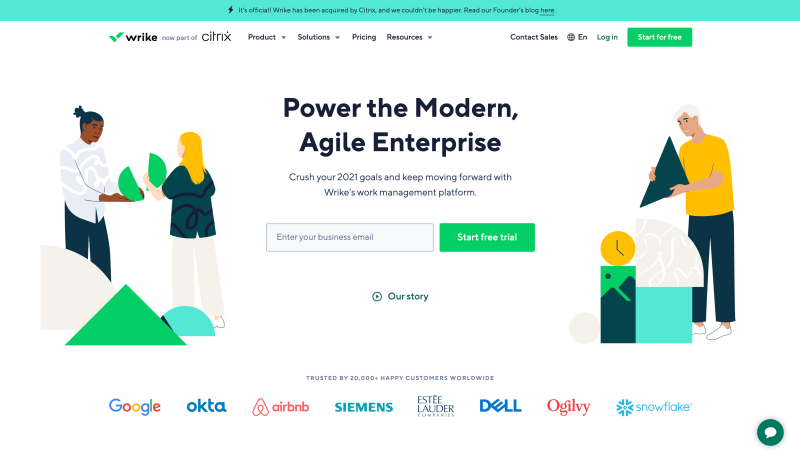
Wrike offers comprehensive roadmapping tools designed to speed up product launches. With Wrike, you can create detailed roadmaps that align closely with stakeholder expectations and provide complete visibility at every project stage.
Ratings: G2- 4.2 stars
Demos: What is Wrike? Wrike Demo & Overview.
Pricing: Plans start at $9.80 per user per month.
Free trial: Yes.
Pros:
Features enterprise-level tools such as Gantt charts, workflow statuses, and file sharing for comprehensive project management.
Includes built-in time tracking to monitor project progress and team productivity.
Offers detailed analytics to measure and optimize the effectiveness of your roadmaps.
Cons:
The platform's interface may be challenging to navigate, especially for new users.
Mobile applications do not match the functionality of the desktop version, limiting on-the-go usability.
The complexity of features requires a steep learning curve, which can complicate onboarding new team members.
12. Roadmunk
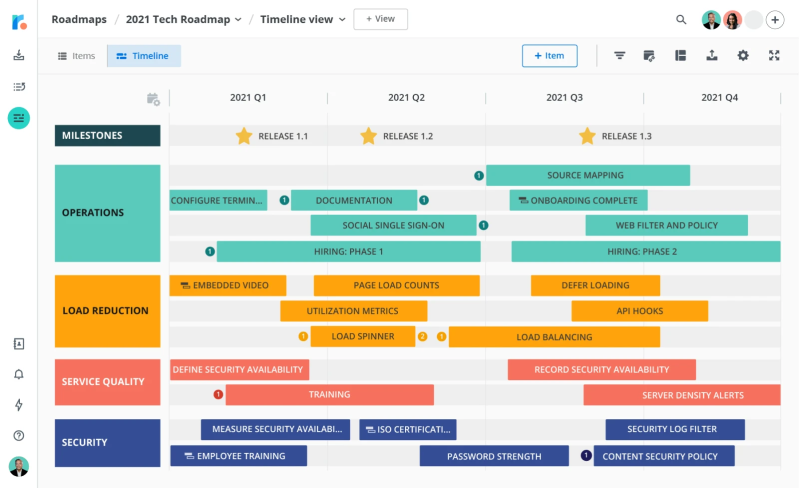
Roadmunk is designed to facilitate clear roadmapping with features that allow teams to establish commitment to dates and ensure alignment around key initiatives, objectives, and milestones. It also caters to agile teams with swimlanes that provide flexibility in timeline commitments.
Ratings: G2 - 4 stars
Demos: Learning Session: Roadmapping with Roadmunk - October 2023.
Pricing: Plans start at $19 per month.
Free trial: Yes.
Pros:
Offers templates to quickly start and standardize roadmaps.
Allows creation of multiple roadmap views from a single data set.
Roadmaps are easily sharable, enhancing collaboration and transparency.
Cons:
Has a steep learning curve which can be a barrier for new users.
Less flexibility in customization compared to other tools in the market.
Features are somewhat limited; cannot create customized feedback forms or portals.
13. Craft
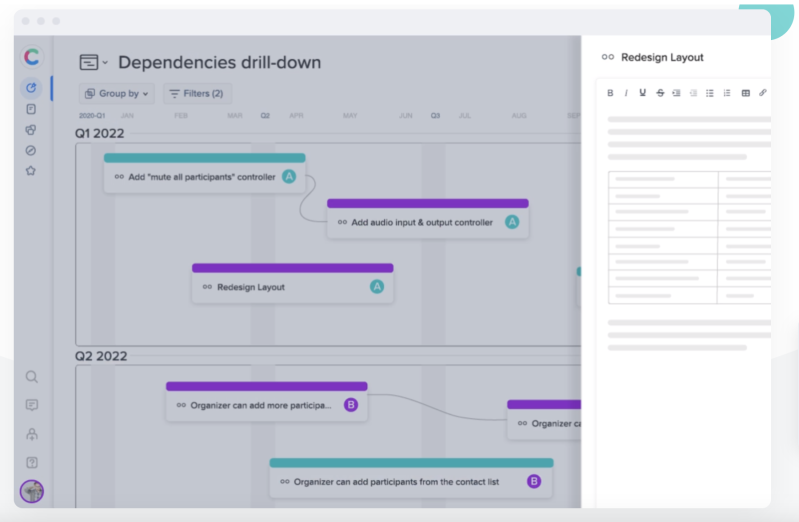
Craft was developed from a personal need by its founders and has evolved to address both project and product management needs. It aims to streamline product strategy development while offering tools for effective decision-making and communication.
Ratings: G2 - 4.5 stars
Demos: You can book a demo on the website.
Pricing: Plans start at $19 per user per month.
Free trial: Yes.
Pros:
Clean interface that simplifies complex product management tasks.
Extensive API support for robust integration with various SaaS tools.
Equipped with advanced features for prioritization, roadmapping, and story mapping.
Cons:
The features present a steep learning curve for new users.
Offers fewer ready-made templates than competitors, potentially slowing initial setup.
Their backlog includes epics and features, as opposed to opportunities and ideas, which makes PMs working towards outputs instead of outcomes.
Category 5: Customer feedback
14. Usersnap
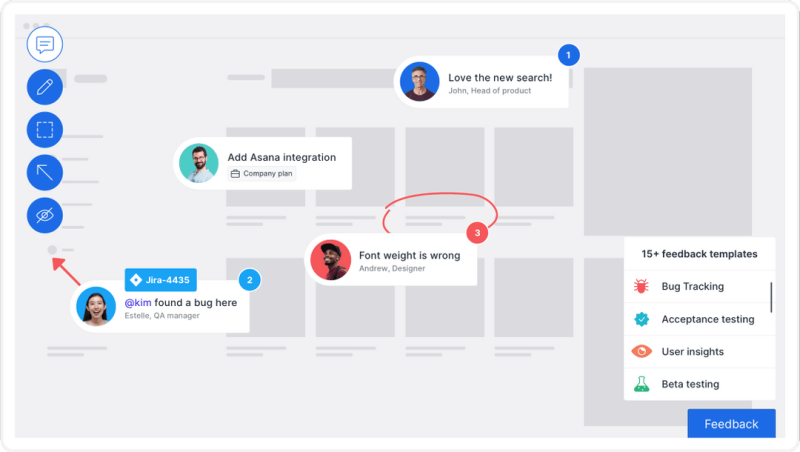
Usersnap enhances customer feedback collection by integrating directly into websites, facilitating real-time UX feedback and customer support. This tool makes it easier for users to provide precise feedback through an unobtrusive widget that opens into a comprehensive customer service menu.
Ratings: G2 - 4.5 stars
Demos: You can book a demo on the website.
Pricing: Plans start at $49 per month for 5 members.
Free trial: Yes.
Pros:
Offers a seamless integration that encourages real-time user feedback directly on the website.
Features a detailed bug reporting tool that allows customers to pinpoint specific issues, enhancing the accuracy of feedback.
Saves time for support teams by directing them straight to the problem areas highlighted by users.
Cons:
The focus on website integration might not be as useful for products without a web interface.
May require technical knowledge to set up and integrate effectively with all website features.
Reliance on user interaction with the widget could miss feedback from less engaged users.
15. Hotjar
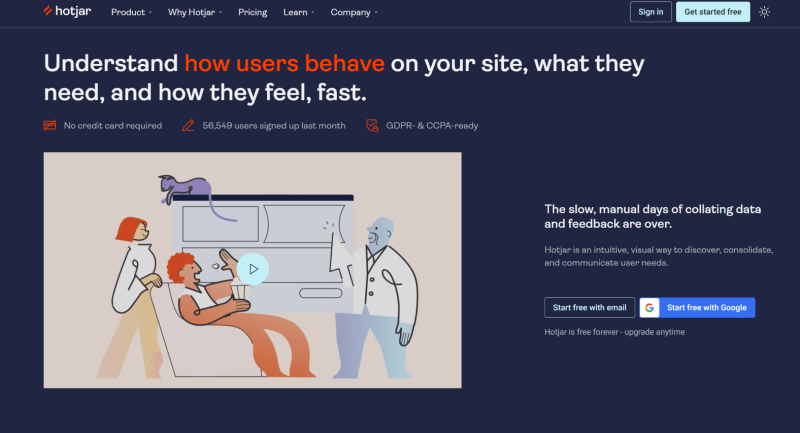
Hotjar is designed to provide a deep understanding of user behaviors, needs, and feelings on websites, making it invaluable for businesses seeking detailed insights into user interactions.
Ratings: G2 - 4.3 stars
Demos: No.
Pricing: Free plan with basic features for up to 35 sessions daily, then $39 per month.
Free trial: Yes.
Pros:
Offers a comprehensive set of tools for visualizing user behavior, including recordings and real-time navigation tracking.
Provides various feedback collection methods, such as surveys and interviews, allowing for diverse data gathering.
Flexible pricing structure with free basic plans for their "Observe," "Ask," and "Engage" platforms, enhancing accessibility for different business needs.
Cons:
Pricing can be complex due to the multiple packages and options, potentially confusing for new users.
Might be overkill for smaller websites or businesses that need simpler feedback collection tools.
The breadth of features requires a learning curve to fully utilize all aspects of the platform effectively.
16. Typeform

Typeform is a web-based platform that excels in creating sleek, stylish surveys with ease, utilizing a rich library of templates that make the design process straightforward and effective.
Ratings: G2 - 4.5 stars
Demos: No.
Pricing: Free plan with basic features, paid plans start at EUR 25 per month.
Free trial: Yes.
Pros:
Provides a user-friendly interface that simplifies the creation of various forms, including quizzes, polls, and surveys.
Offers aesthetically pleasing design options that enhance user engagement.
Features 'Logic Jumps' for streamlined survey building and numerous integration options such as Slack, Zapier, MailChimp, and Salesforce.
Cons:
Lacks some advanced data analysis features found in more comprehensive feedback tools.
Focus on design might limit the depth of functionalities for complex data collection needs.
Primarily suitable for surface-level insights rather than detailed analytical tasks.
17. Surveysparrow
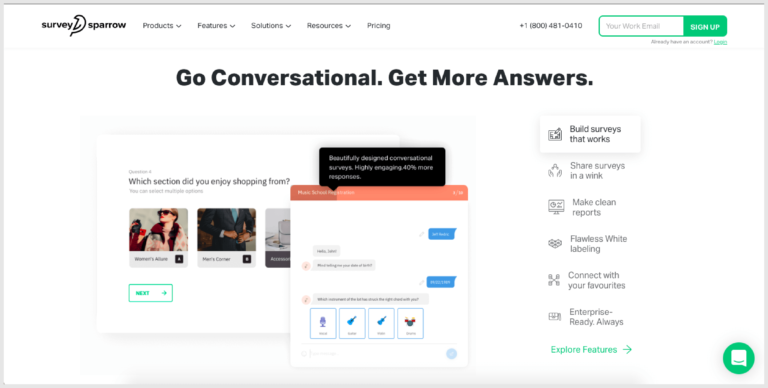
SurveySparrow positions itself as a unique continuous improvement platform designed to close the customer feedback loop effectively. It focuses on enhancing customer engagement through enticing and conversational surveys.
Ratings: G2 - 4.5 stars
Demos: No.
Pricing: Free plan with basic features, paid plans start at EUR 25 per month.
Free trial: Yes.
Pros:
Utilizes a conversational interface that promises to increase customer response rates by 40%.
Enables the creation of customized surveys tailored to specific user groups, enhancing relevance and engagement.
Allows for the importation of user contexts and the creation of custom lists, aiding in targeted feedback collection.
Cons:
The focus on a conversational style might not suit all types of survey requirements or target demographics.
Customization features, while powerful, may require more setup time to fully leverage.
May not provide as in-depth analytics as more traditional survey platforms, focusing instead on engagement and response rates.
18. Canny
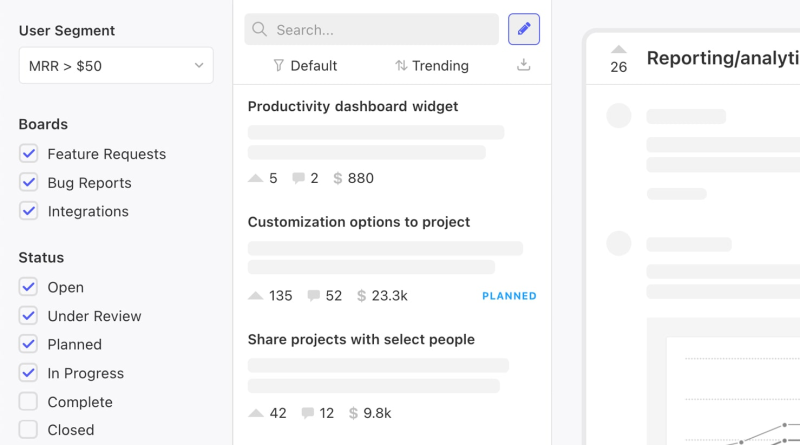
Canny is designed to streamline the collection, organization, and analysis of product feedback, directly aiding in product development. Since its founding in 2015 by Sarah Hum and Andrew Rasmussen, Canny has grown to include features like minimal roadmapping and embedding options, which can be integrated directly into products. This bootstrapped company has continually adapted to better serve the needs of product managers.
Ratings: G2 - 4.5 stars
Demos: You can request a demo on their website.
Pricing: Free plan with basic features, paid plans start at $99 per month.
Free trial: Yes.
Pros:
Offers a direct method for collecting customer feedback via a voting-style forum, enhancing user engagement and prioritization of features.
Provides an easy-to-use, clean, and intuitive interface that supports quick setup and navigation.
Allows embedding directly into products, making it highly accessible for users to give feedback and see future plans.
Expanded functionality now includes basic roadmapping, linking customer feedback with product development stages.
Cons:
The roadmapping features are minimal and may not fully support complex product management activities like discovery and research.
Focuses primarily on feature requests, which may not effectively address deeper, underlying product issues.
Uses a voting system for feedback prioritization, which can result in popularity-driven decisions rather than value-driven development.
Restrictive roadmap capabilities and handling of multiple workflows may limit its usefulness for more complex or larger organizational needs.
Category 6: Objectives and key results (OKRs)
19. Lattice
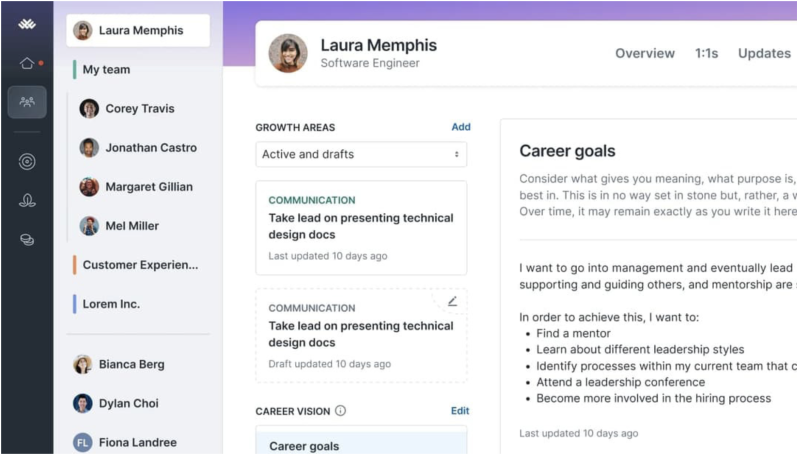
Lattice offers a robust solution for setting and tracking OKRs, equipped with features like custom dashboards, progress tracking, and detailed reporting. It integrates employee development tools to enhance the achievement of company and team objectives through growth and development.
Ratings: G2 - 4.7 stars
Demos: You can request a demo on their website.
Pricing: Starts at $11 per user per month.
Free trial: No.
Pros:
Intuitive and user-friendly interface makes it accessible for new users.
Personalized customer support assists in setting up and configuring the platform to meet specific team needs.
Integrates employee development tools with OKR tracking, supporting holistic employee and organizational growth.
Cons:
Costs may be a barrier for smaller companies or teams with limited budgets.
Initial setup can be complex due to the depth and breadth of features available.
The comprehensive nature of the tool might overwhelm users who need simpler OKR solutions.
20. Perdoo
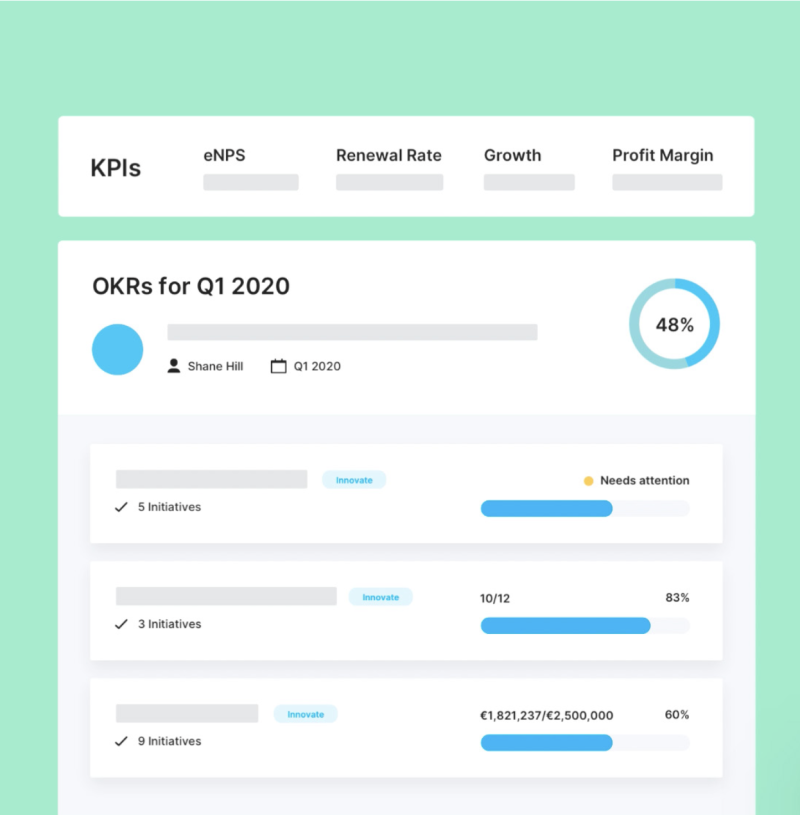
Perdoo specializes in performance management through a focused OKR tracking system. It offers features like custom dashboards, real-time progress tracking, and automated reporting, designed to simplify the alignment and management of team goals and objectives.
Ratings: G2 - 4.4 stars
Demos: You can request a demo on their website.
Pricing: The free plan has basic features and is up to 5 users, the next package starts at $9.9 (billed quarterly) and requires a minimum of 10 users.
Free trial: Yes.
Pros:
Provides comprehensive OKR tracking capabilities to set, track, and manage objectives and key results efficiently.
Features a user-friendly UI that facilitates easy navigation and usage.
Enhances transparency in goal alignment and progress tracking across teams.
Cons:
The platform may present a steep learning curve due to its comprehensive and detailed functionalities.
Costs associated with the software may pose a barrier for smaller teams or organizations with limited budgets.
The complexity of features, while beneficial for deep management, can complicate the initial adoption and ongoing use for some teams.
21. Workboard
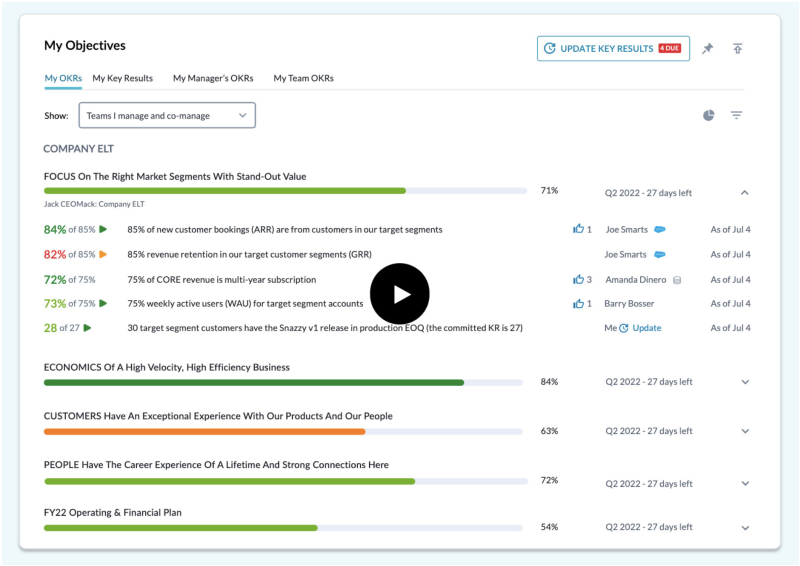
Workboard positions itself as a comprehensive solution for OKR management and strategy execution, boasting a robust set of features designed to set, align, track, and communicate OKRs effectively across enterprises.
Ratings: G2 - 4.7 stars
Demos: You can request a demo on their website.
Pricing: According to Capterra, the pricing of Workboard starts at $20. Pricing is not announced on Workboard website.
Free trial: Yes.
Pros:
Provides a full suite of tools for comprehensive OKR management, supporting ambitious goal setting and faster achievement.
Markets itself as the enterprise standard, indicating a strong focus on large-scale strategic execution.
User feedback highlights the platform's ability to drive significant organizational achievements.
Cons:
Pricing information is not readily available, requiring potential users to sign up for a demo to learn more, which could be a barrier for initial exploration.
Some users have reported issues with responsiveness and difficulty accessing support, which could hinder problem resolution and user satisfaction.
Introducing another specialized software into an existing workflow may present integration and adoption challenges for teams.
22. Prodpad
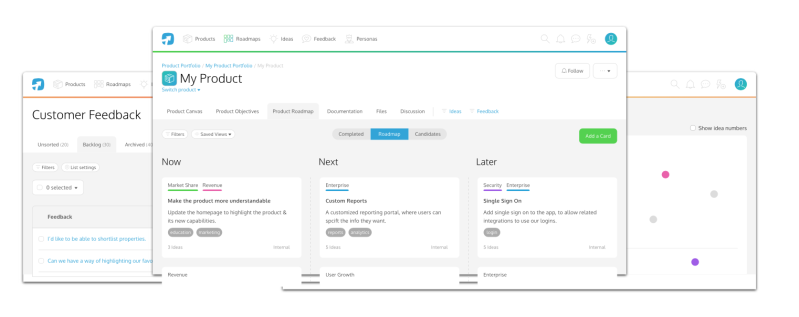
ProdPad is a product management tool that emphasizes outcome-oriented strategies, incorporating a dedicated OKRs feature to align strategic goals with product development initiatives.
Ratings: G2 - 4.3 stars
Demos: You can request a demo on their website.
Pricing: The essential package is at $30 per person per month.
Free trial: Yes.
Pros:
Integrates OKRs with the product roadmap, enhancing transparency and strategic alignment.
Helps set clear priorities, preventing aimless work and focusing efforts on impactful outcomes.
Promotes clear communication of strategy and direction, facilitating better team understanding and cooperation.
Includes features for tracking progress and accountability, ensuring goals are met effectively.
Cons:
Offers limited flexibility in adapting the platform to unique team processes, potentially forcing a standardized workflow.
Only allows linking of key results to roadmap initiatives, which restricts integration with other types of product work such as opportunities, epics, features, or tasks.
Category 7: Project and task management
23. Asana
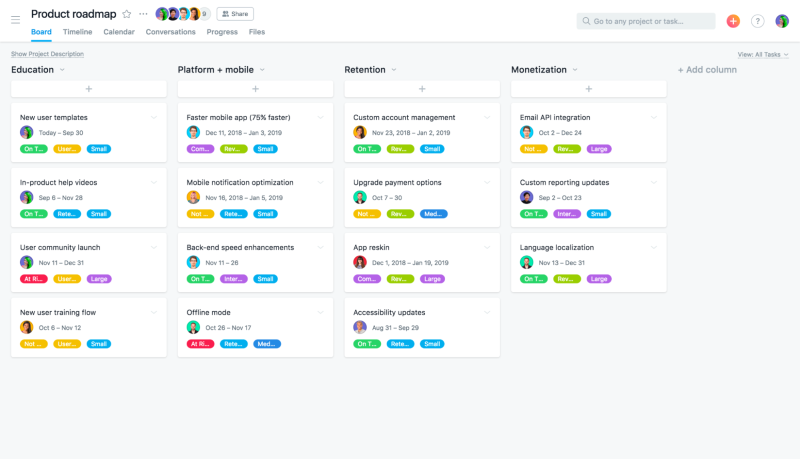
Asana is renowned for its capability to organize and track tasks, supporting teams with project management and enhancing productivity through clear timelines and effective communication tools. While it excels in task management and is utilized by organizations such as NASA and Salesforce, it lacks specific features tailored for product management such as outcome-based roadmaps and backlog management.
Ratings: G2 - 4.3 stars
Demo: Yes.
Pricing: For individuals and small teams, there is a free basic package, and the paid ones start at $13,45 per month.
Free trial: Yes.
Pros:
Strong task management features facilitate day-to-day tracking for diverse teams, ensuring that tasks are clearly outlined and managed.
Highly scalable and customizable, making it ideal for team growth and adoption across various departments.
Exceptional user experience designed to minimize friction, making it easy for teams to adopt and use effectively.
Cons:
Lacks features specific to product management, such as outcome-based roadmaps and comprehensive feedback and discovery process management.
Prioritization is limited to basic labels like high, medium, and low, which may not suffice for more detailed prioritization needs.
While excellent for task management, its focus does not fully support the nuanced requirements of product management or complex discovery processes.
24. Clickup
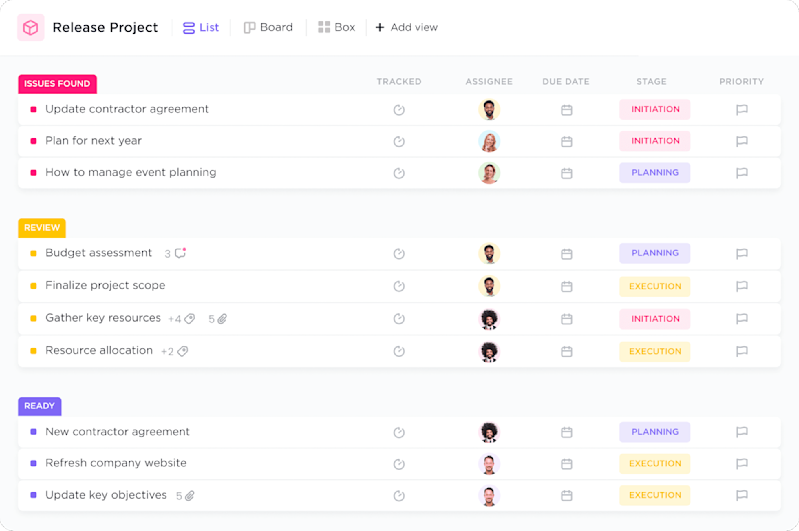
ClickUp is a multifaceted project management solution that enhances team planning, organization, and collaboration through its diverse set of features, including tasks, documents, goals, chat, and whiteboards. Its versatility makes it suitable for a wide range of project types, fostering agile development and remote collaboration.
Ratings: G2 - 4.7 stars
Demo: No.
Pricing: You can start with a basic plan for free, packages start at $7 per user per month.
Free trial: Yes.
Pros:
Offers multiple views (to-do lists, boards, box, calendar, and Gantt) to adapt to various workflow preferences and project management needs.
Highly customizable, allowing teams to tailor workflows and metadata to their specific requirements.
Cloud-based and available on nearly all devices, ensuring team members can stay connected and sync effortlessly.
Cons:
The variety of views and customization options, while beneficial, can also overwhelm users, making the platform seem complex and difficult to master.
Some users find the user interface unintuitive, which can complicate navigation and reduce efficiency, particularly for those not familiar with complex apps.
Initial adoption may be challenging due to the steep learning curve associated with its comprehensive functionalities.
25. Confluence
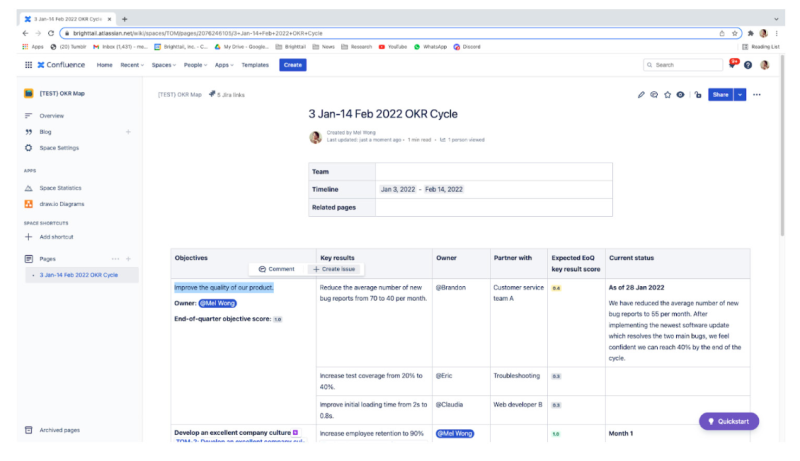
Confluence, developed by Atlassian, is a project management solution that enhances organizational efficiency by facilitating the creation, collaboration, organization, and review of project documents. Available in both cloud-based and on-premise deployments, Confluence serves as a versatile tool for managing a wide array of documentation needs from meeting notes to product requirements.
Ratings: G2 - 4.1 stars
Demo: No.
Pricing: A free forever version for up to 10 users, then packages start at $5 per user per month.
Free trial: Yes.
Pros:
Features a powerful editor that enables the creation of various types of content and supports collaborative review and feedback directly within documents.
Offers a knowledge management module that acts as a centralized repository, allowing users to easily access and search for content relevant to specific project requirements.
Integrates seamlessly with JIRA, providing enhanced project transparency and enabling effective task management that includes delegating, monitoring, and tracking task progress.
Cons:
Managing confidential data requires careful setup to restrict access appropriately, which can be complex depending on organizational needs.
While it supports a range of document management and collaboration functions, it might be less intuitive for users unfamiliar with Atlassian’s ecosystem.
Some users may find the interface to be less user-friendly compared to more streamlined project management tools, potentially impacting adoption and productivity.
Category 8: Product design
26. Figma
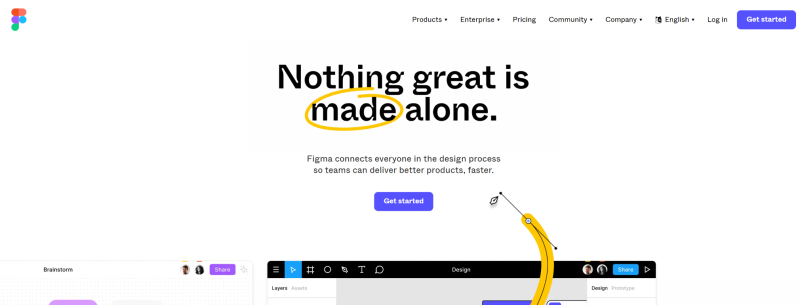
Figma is renowned for its robust capabilities in UI design and prototyping, facilitating seamless collaboration among team members and stakeholders. Its popularity is underscored by its recent acquisition by Adobe for $20 billion, highlighting its status as a top choice in the product design market.
Ratings: G2 - 4.7 stars
Demo: No.
Pricing: They have a free basic plan, a plan for students and educators starting at $12 per seat per month (billed annually). The plan for organizations start at $45 monthly and for enterprise at $75 monthly.
Free trial: Yes.
Pros:
Accessible to both designers and non-designers, Figma is praised for its ease of use and quick learning curve.
Enhances collaboration by allowing multiple users to view, edit, and discuss designs in real-time on a single platform.
Excellently balances the functionalities of UI design and prototyping, offering comprehensive tools for both.
Cons:
Requires an internet connection for all operations, as it does not support offline use.
Can become cluttered when multiple stakeholders are involved, making it difficult to track comments and changes.
The user interface needs further refinement to handle large-scale collaborations more effectively.
27. Invision
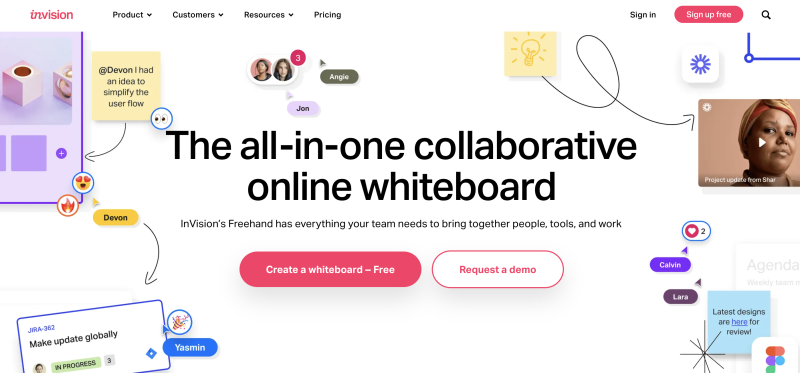
InVision is a popular tool designed specifically for prototyping and facilitating team collaboration. It allows designers to quickly create prototypes, share designs, and gather feedback efficiently, all in real-time.
Ratings: G2 - 4.4 stars
Demo: No.
Pricing: The prototyping app has a free forever package for up to 10 users. The unlimited costs $8 per user per month.
Free trial: Yes.
Pros:
Features a user-friendly drag-and-drop interface that simplifies the feedback process for both designers and non-designers.
Enhances the feedback loop by allowing collaborators to comment directly on the latest version of a design through a single shared link, eliminating the confusion of multiple file versions.
Ideal for non-technical stakeholders, as the InVision link provides an intuitive way for them to contribute feedback without needing to navigate complex design software.
Cons:
Lacks integrated design creation tools, requiring users to create their designs in another application before importing them into InVision for prototyping and feedback.
While free for individuals and small teams, InVision becomes costlier for larger teams at $7.99 per user, which can add up for larger projects or enterprises.
28. Adobe illustrator

Adobe Illustrator (Ai) is a powerhouse in the design industry, known for its robust capabilities in vector design. As one of the original tools for digital design, it continues to be a go-to for many product designers who appreciate its versatility and precision.
Ratings: G2 - 4.6 stars
Demo: No.
Pricing: For individuals the packages start at $22.90 per month, while for teams it starts at $37.90 per month per licence.
Free trial: Yes.
Pros:
Excelled in creating refined, high-quality vector designs that maintain clarity regardless of zoom level.
Highly versatile, suitable for a range of design tasks including print graphics, logo design, and software interface design.
Compatible across multiple devices, including PC and Mac, ensuring reliability and accessibility for various user needs.
Cons:
Features a steep learning curve, especially for those not familiar with the Adobe suite, which can be daunting for new users.
Requires significant disk space, which can lead to performance issues when used in conjunction with other software on devices with limited storage.
Costly compared to its competitors.
Category 9: Product analytics
29. Mix panel
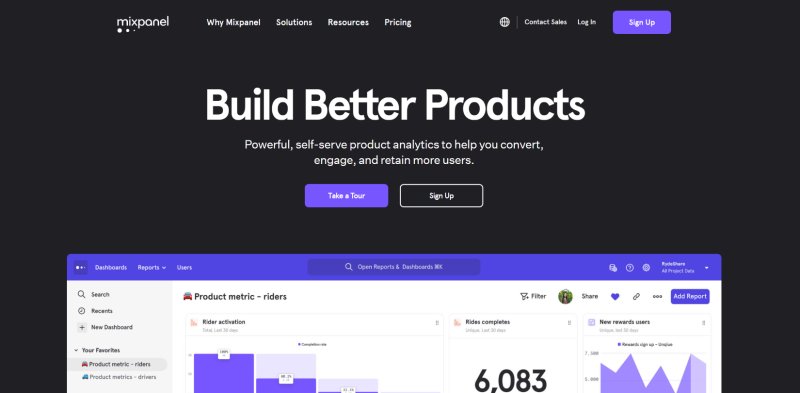
Mixpanel stands out as a preferred analytics tool among product teams, offering advanced capabilities to track and understand user behavior. Its comprehensive features enable detailed interaction data, funnel analysis, and cohort tracking, empowering teams to optimize product performance through data-driven strategies.
Ratings: G2 - 4.6 stars
Demo: No.
Pricing: Offers a free version for up to 20 million monthly events. Packages start at $28 per month and scale with the number of events, while enterprise starts at $833 per month and scales with events.
Free trial: Yes. Startups get 1 year for free.
Pros:
Provides robust analytics with features like A/B testing and real-time data tracking, enabling timely and informed decision-making.
Offers a generous free tier allowing up to 20 million events per month, which includes core reporting on user journeys and access to quick start templates.
Supports unlimited integrations and collaborators, enhancing its flexibility and utility across various team sizes and functions.
Cons:
While the free tier is quite comprehensive, more advanced features such as unlimited saved reports and advanced sharing controls are locked behind a paid plan starting at $20/month.
The depth of data and multitude of features might be overwhelming for teams new to analytics or those with simpler needs.
For teams requiring extensive, rapid data analysis, the cost can escalate, potentially making it less accessible for startups or smaller teams.
30. Pendo
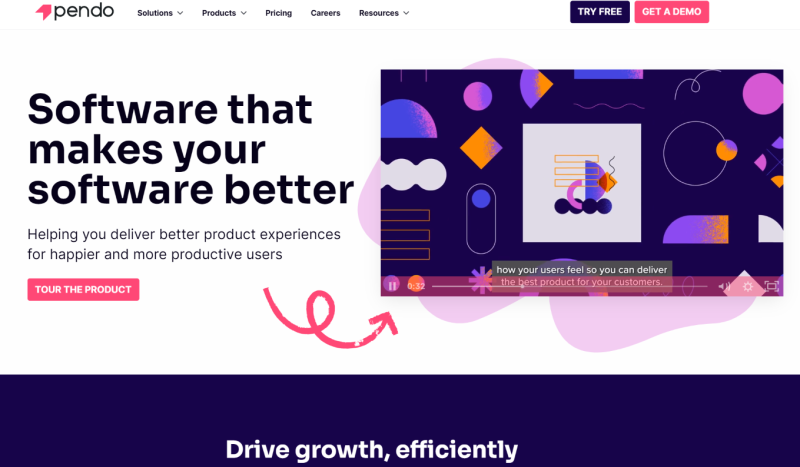
Pendo is a comprehensive platform designed to empower enterprise product teams by providing essential data to enhance user experiences. It effectively addresses key use cases such as user onboarding, in-app support, and product-led growth, making it a valuable tool for modern businesses.
Ratings: G2 - 4.4 stars
Demo: You can request a demo on their website.
Pricing: Offers a free version for up to 500 active users, for the other packages you need to contact sales.
Free trial: Yes.
Pros:
Offers a visually appealing interface that makes it easy to gather customer insights, run NPS surveys, and deliver user guides.
Includes a data explorer feature for deep dives into data, enhancing the ability to derive meaningful insights.
Provides free access for up to 500 monthly active users, which includes product analytics, in-app guides, NPS surveys, and roadmapping capabilities, making it accessible for early-stage companies.
Cons:
Pricing can be prohibitive for startups and smaller companies as it tends to be on the higher end.
Users have expressed a need for improved search capabilities and additional filtering options to better manage and navigate the data.
Configuration, while generally straightforward, can vary in complexity depending on specific enterprise needs and scale.
31. Userpilot
Userpilot is designed to enhance product adoption and user experience by integrating product analytics, in-app engagement, and survey tools. This all-in-one platform is tailored for Product & UX teams looking to optimize onboarding flows, product announcements, user feedback collection, and self-serve support—all without requiring any coding.
Ratings: G2 - 4.6 stars
Demo: You can request a demo on their website.
Pricing: Packages start from $299 per month for up to 2,000 monthly active users.
Free trial: Yes.
Pros:
Facilitates the creation of code-free user onboarding flows, product announcements, and in-app support, streamlining user interaction and improving product adoption.
Equipped with comprehensive product analytics tools including funnels, trends, paths, and cohorts, enabling teams to make data-driven decisions.
Offers new custom dashboards that can be created using drag-and-drop functions or pre-designed templates, enhancing data visualization and reporting.
Cons:
The breadth of features and capabilities might be overwhelming for smaller teams or startups with limited resources.
As a comprehensive tool, it may require a significant learning curve to fully utilize all its functionalities effectively.
Depending on the complexity of the analytics and customizations, setup and ongoing management might require more time and effort than anticipated.
32. UXcam
UXCam offers an all-encompassing analytics solution for mobile apps, focusing on understanding user behavior through a combination of qualitative and quantitative data. Initially centered around session replay and heatmaps, UXCam has expanded to integrate robust analytical tools such as funnels, retention charts, and customizable dashboards.
Ratings: G2 - 4.7 stars
Demo: You can request a demo on their website.
Pricing: They have a free package up to 3,000 monthly sessions. For advanced packages you need to contact sales.
Free trial: Yes.
Pros:
Provides a deep dive into user interactions with session replays and heatmap technology, allowing businesses to visually track user movements and engagements within their app.
Offers quantitative tools like funnels and retention charts that help identify where users are dropping off and gauge long-term engagement.
Enables detailed analysis by allowing users to zoom into specific areas of concern highlighted by the data to understand underlying issues.
Cons:
May require a significant investment of time to fully understand and utilize all the features effectively, given its data capabilities.
The integration of both qualitative and quantitative data, while powerful, can be complex and overwhelming for teams new to advanced analytics.
Reliance on high-quality data input; the accuracy of insights depends heavily on the initial data capture setup.
Category 10: AI tools for product managers
33. ChatGPT

Developed by OpenAI, ChatGPT is a sophisticated language model designed to assist product managers by automating customer interactions, analyzing feedback, and generating content, thereby enhancing decision-making and efficiency in product management.
Ratings: G2 - 4.7 stars
Demo: No.
Pricing: The free plan gives you access to the 3.5 model, while the paid plans for individuals cost $20 per month, and for teams cost $30 per user per month.
Free trial: Yes.
Pros:
Provides instant, consistent responses, improving customer support and engagement.
Analyzes feedback and sentiments from large volumes of text, offering valuable insights for product strategy.
Generates marketing content and product documentation, saving time for product managers.
Cons:
May occasionally produce responses that lack contextual accuracy, requiring ongoing training and updates.
Needs regular monitoring to maintain interaction quality and ensure alignment with organizational standards.
Effectiveness depends on the scope and quality of its training data, potentially limiting performance in niche areas.
34. Gemini

Google Gemini combines Google's advanced machine learning capabilities with its extensive data ecosystem to offer a powerful tool for product managers. Designed to provide deep insights into market trends and customer preferences, Gemini serves as both a marketing and analytics powerhouse, seamlessly integrating with Google Cloud to automate and optimize marketing efforts.
Ratings: G2 - 4.4 stars
Demo: No.
Pricing: There is a free plan for both their 1.0 Pro and 1.5 Pro model with limitations. Their paid plans are based on numbers of inputs and outputs.
Free trial: Yes.
Pros:
Integrates smoothly with Google's suite, enhancing functionality with top-notch analytics and robust security.
Excels in market analysis and forecasting, utilizing Google’s data analytics for precise insights into consumer behavior.
Automates marketing strategies, optimizing ad campaigns for better engagement and effectiveness.
Cons:
Costs can escalate quickly with heavy usage due to the pay-as-you-go pricing structure within Google Cloud.
High dependency on Google’s infrastructure might limit flexibility and increase costs for users not fully integrated into Google’s ecosystem.
Requires careful management of data access to maintain security and control over sensitive information.
35. Claude AI

Developed by Anthropic, Claude AI is engineered to prioritize safety and ethical standards in AI applications. This tool is particularly suitable for teams that value transparent and responsible AI usage, providing human-like text generation that supports authentic and ethically-guided interactions. Claude AI's design focuses on ethical decision-making, enhancing content creation and customer interactions with a strong emphasis on trust and quality.
Ratings: G2 - 4.7 stars
Demo: No.
Pricing: Their plans are based on inputs and outputs, with prices starting from $0.8 and up to $24 per million tokens.
Free trial: Yes.
Pros:
Strong commitment to ethical AI practices, ensuring responsible usage and fostering trust among users.
Offers a straightforward and clear user interface, facilitating ease of use and seamless integration into existing processes.
Specializes in producing detailed training materials and refining customer feedback, prioritizing high quality and precision in communications.
Cons:
Pricing may require discussions with the provider, which could complicate financial planning for prospective users.
The specifics of integration into existing setups and its scalability might require detailed conversations, potentially delaying full deployment.
Long-term growth adaptability and scalability within an organization might need further clarification and ongoing dialogue with the provider.
Not available in many regions yet.
Conclusion
You need the right tools to do product management right.
The 36 tools we've explored offer a range of capabilities to streamline tasks, enhance strategic planning, and improve communication. Choosing the right tool depends on your team's specific needs and the challenges you face.
The right tools can transform your product management practices, making it easier to achieve your goals and drive business success. As you consider which tools to integrate into your workflow, look for those that align closely with your team’s needs and can scale with your growth. airfocus is an excellent place to start, offering the flexibility and capabilities needed to manage products effectively and be a single source of truth for product teams.
Whether you're at a startup or a large enterprise, airfocus provides a comprehensive suite of features to support your product management journey and scale with you as you grow. With its ability to streamline managing a portfolio of products and their roadmaps, it stands as the best choice especially for large enterprises.
Frequently asked questions
Why should product managers not use Excel sheets and PowerPoint for their product management work?
Using Excel sheets and PowerPoint for product management can lead to scattered and disconnected workflows. Unlike dedicated product management tools, these common office applications do not inherently link your work to strategic objectives like roadmaps or OKRs. Tools like airfocus provide an integrated product operating system where everything is connected—ensuring that all team members are aligned and focused, dramatically improving productivity and strategic execution.
What is a modular product management tool?
A modular product management tool is designed to adapt and scale by integrating separate functionalities into one cohesive platform. Unlike tools dedicated solely to specific tasks like roadmap visualization or feedback capture, modular tools offer the flexibility to add or adjust features as needed. This adaptability ensures that as your product and team grow, your tool grows with you, facilitating better scalability and enabling continuous adaptation to changing market demands and business needs. It allows teams to maintain a single, integrated tool over time, reducing the need for multiple tools and the manual effort to synchronize them across various functions.
How can a product management tool enhance team collaboration?
Effective product management tools enhance team collaboration by centralizing communication and information in one accessible location. This centralization helps in streamlining the decision-making process as it reduces the need for back-and-forth emails and meetings. Additionally, these tools often feature real-time updates, task assignments, and progress tracking, which keep everyone on the same page and focused on common goals. The integration of feedback loops and prioritization frameworks within the tool also ensures that every team member's insights are captured and valued, fostering a more collaborative and inclusive work environment.
What are the key benefits of integrating customer feedback into product management tools?
Integrating customer feedback directly into product management tools is crucial for developing products that truly meet user needs. This integration allows teams to quickly capture, prioritize, and act upon feedback, ensuring that customer insights directly influence product development strategies. It also enables continuous feedback loops, where product improvements are consistently informed by user experiences, leading to higher customer satisfaction and better market fit. Moreover, having this capability within the tool simplifies the process of tracking changes and measuring the impact of specific adjustments based on real user feedback.

Quadri Oshibotu

Read also

Experience the new way of doing product management

Experience the new way of doing product management






